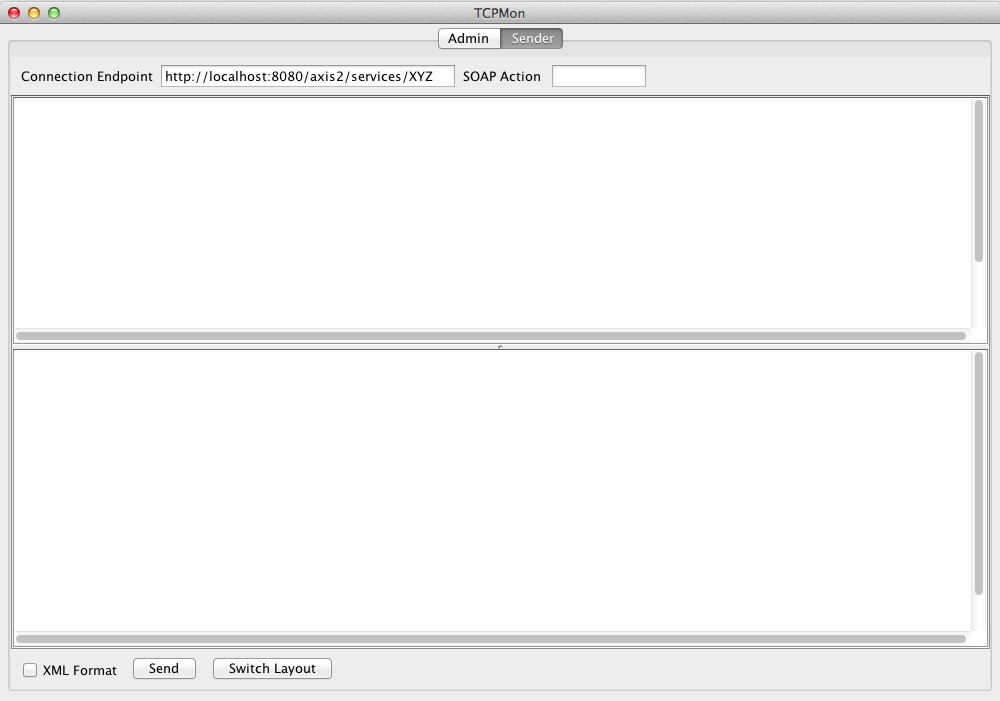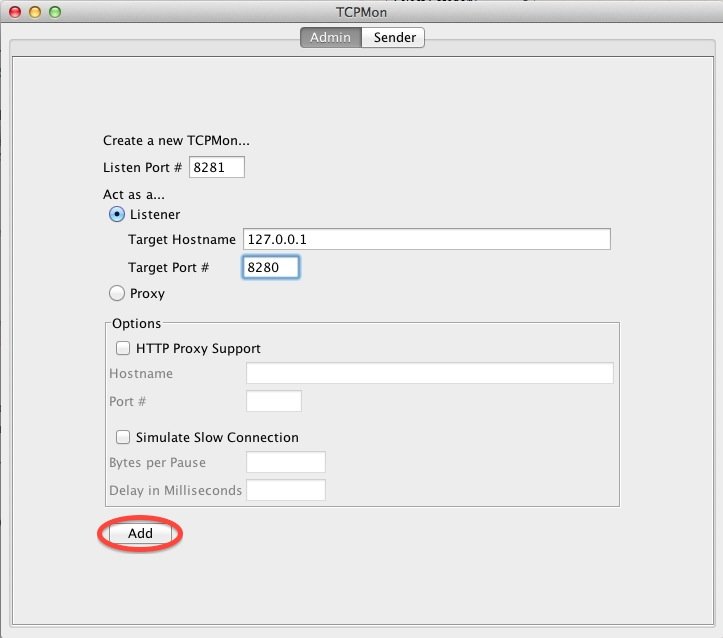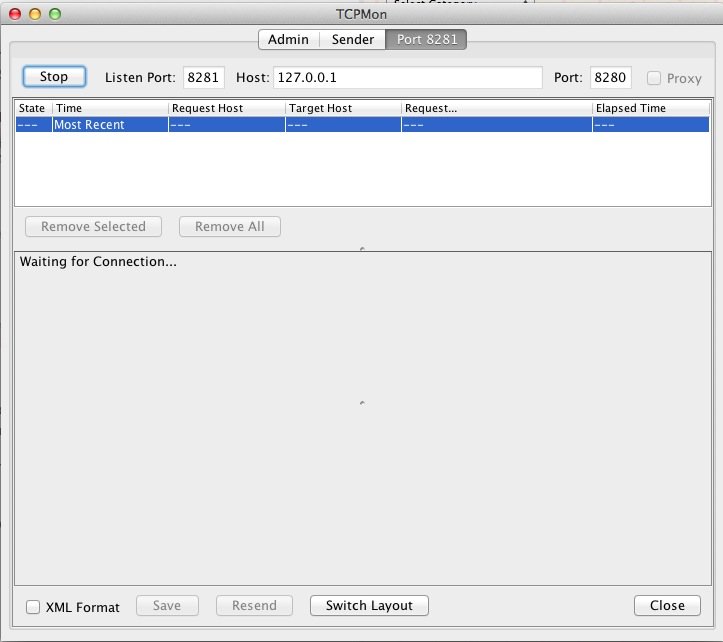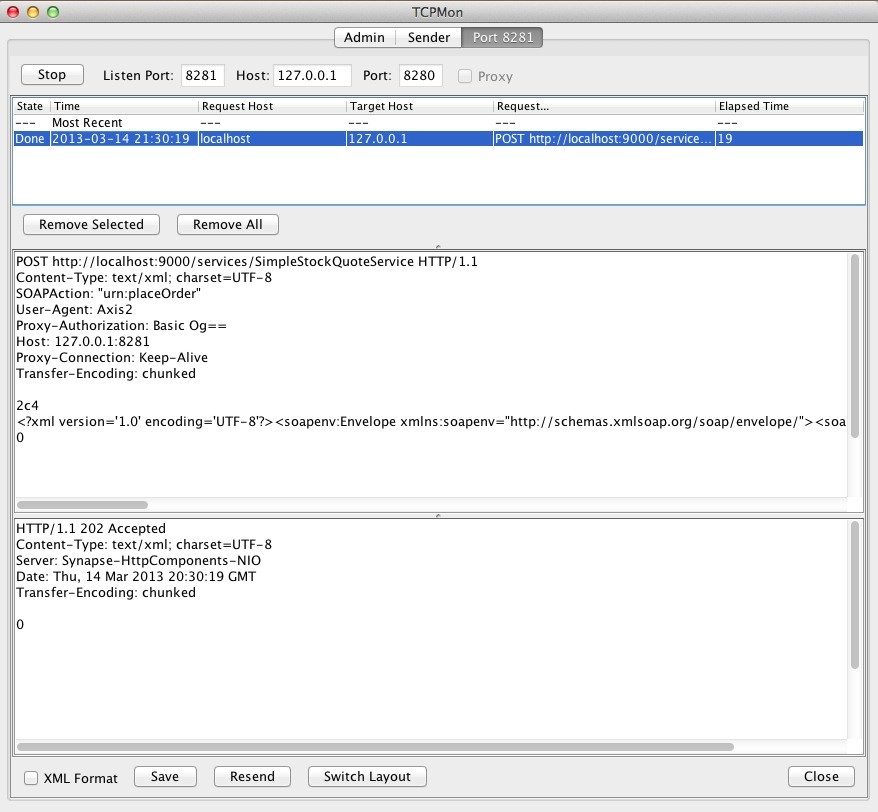One way messaging with WSO2 ESB
As I posted before I am currently working with the WSO2 ESB. To get a good understanding of this ESB I have been walking through the samples (haven’t finished all of them yet). Example 12 is about one-way messaging with the ESB and makes use the TCP Monitor to make it visible. I have described before how to setup a similar tool called ‘TcpTunnelGUI’ but actually I prefer the TCP Monitor. To use the tool see the manual here or here. By the way, the tool is available with the WSO2 ESB installation so you don’t have to download it and install it. Simply go to the ‘$CARBON_HOME/bin’ directory and give the command:./tcpmon.sh
To see the example 12 in action with Tcp Monitor do the following:
- Start the WSO2 ESB
This example uses the ESB setup that is similar as the one for example 1 so start the ESB by navigating to the ‘$CARBON_HOME/bin’ directory in a terminal and enter the following command:
./wso2esb-samples.sh -sn 1
- Start the Apache Axis server
Next step is to start the Axis server where the SimpleStockQuote is deployed. To do this open a new terminal and navigate to ‘$CARBON_HOME/samples/axis2Server’ directory. Enter the command ./axis2server.sh.
- Start the TcpMonitor
If you haven’t done already start the Tcp Monitor. Do this by opening a new terminal and browse to ‘$CARBON_HOME/bin’ and enter the command ./tcpmon.sh
This should start the Tcp Monitor tool:

- Configure the TcpMonitor
We are going to listen to port 8281 and forward the incoming traffic to 8280 (that is where our ESB is running it’s proxy service).
Here is how to set this up in the Tcp Monitor:

After clicking the ‘Add’ button you see the TcpMonitor waiting for a connection:

So let’s send a message through it.
- Run the Axis client
I made a small change to the statement as shown in the example page. Open a new terminal and run the following command from the directory ‘$CARBON_HOME/samples/axis2Client’: ant stockquote -Daddurl=http://localhost:9000/services/SimpleStockQuoteService -Dprxurl=http://localhost:8281/ -Dmode=placeorder
- Check the results
In the TCP Monitor we see that there is a line added to the TCP Monitor and in the lower part we see the incoming and outgoing request:

Here is the request sent by the Axis client:
<soapenv:Envelope xmlns:soapenv='http://schemas.xmlsoap.org/soap/envelope/'>
<soapenv:Header xmlns:wsa='http://www.w3.org/2005/08/addressing'>
<wsa:To>http://localhost:9000/services/SimpleStockQuoteService</wsa:To>
<wsa:ReplyTo>
<wsa:Address>http://www.w3.org/2005/08/addressing/none</wsa:Address>
</wsa:ReplyTo>
<wsa:MessageID>urn:uuid:44ba7c6b-1836-4a62-8e40-814813a64022</wsa:MessageID>
<wsa:Action>urn:placeOrder</wsa:Action>
</soapenv:Header>
<soapenv:Body>
<m0:placeOrder xmlns:m0='http://services.samples'>
<m0:order>
<m0:price>154.76332953114107</m0:price>
<m0:quantity>8769</m0:quantity>
<m0:symbol>IBM</m0:symbol>
</m0:order>
</m0:placeOrder>
</soapenv:Body>
</soapenv:Envelope>The important thing to notice in the request is the following element in the header:
<wsa:ReplyTo>
<wsa:Address>http://www.w3.org/2005/08/addressing/none</wsa:Address>
</wsa:ReplyTo>With this element in the header we tell the we service we don’t expect a response. So what we get as a response is just the 202 response code as we can see in the TCP Monitor:
HTTP/1.1 202 Accepted Content-Type: text/xml; charset=UTF-8 Server: Synapse-HttpComponents-NIO Date: Thu, 14 Mar 2013 20:30:19 GMT Transfer-Encoding: chunked 0
That completes this example, only a few more to go!
Reference: One way messaging with WSO2 ESB from our JCG partner Pascal Alma at the The Pragmatic Integrator blog.





